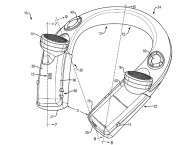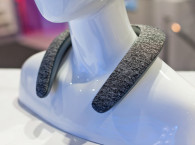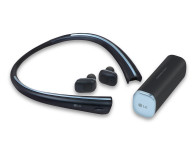Just think about it. Traditional hearing aids were actually very basic and limited filter/amplifiers. Now, they have sensors, they can be connected to the Internet, they connect to smartphones... This enables people with hearing disabilities to fine-tune their own hearing aids in a precise way, while also monitoring their health, use voice assistants, take calls and efficiently communicate with the world. With Bluetooth 5, NFC/NFMI and improvements in battery life, very soon these products have the potential to become the most popular format and sell in the same numbers as prescription glasses.

Probably the biggest constraint right now is battery life. If we want earbuds to be light and comfortable, while being always on (especially now with some models featuring built-in voice assistants), processing audio all the time and communicating efficiently (and streaming music), there's no way the battery will last a normal 12-hour day. One current alternative is to connect those earbuds with short wires and connect them to a neckband storing a larger capacity battery. LG Electronics (LG) was not the first company to explore the idea, but they had the first commercially successful model in 2015 with the HBS-900 and their TONE around-the-neck wireless headsets. Basically, a slim and elegant design, combining convenience with longer battery life, allowed by the neck piece. Many other brands have started to explore the concept and virtually all have a similar model - I would highlight the recent Sennheiser HD1 In-Ear Momentum Wireless Neckband, which offers great audio quality, great design and 10-hour battery life. The leather neckband is so attractive and nice to wear that I thought Sennheiser could actually sell a new fashion line of jackets and shirts with the neckband attached to the collar. (You're welcome!)
But LG is still probably the leading company exploring the concept and its TONE range keeps expanding, including most recently the LG TONE Free, adding wireless earbuds to the familiar neckband concept. That is, the neckband is the charger that holds and charges the earbuds. It provides extra battery power and vibration alerts for incoming calls and text messages, and also provides a secure place to store the earbuds when not in the user's ears. The obvious trade-off is limited mobility during sports and fitness activities (unless you sew the neckband to a collar...)
But let's forget for a moment the earbuds and focus more on the neckband. I remember in the 1990s, when Sennheiser introduced a much-improved version of its RF wireless headphones - using tiny plug-in rechargeable battery packs that unfortunately would get lost, and wire antennas that broke easily. Still, those allowed me to listen to the TV at night and, as I soon discovered, even walk the dog around the house, wearing headphones and listening to music with minor interferences. I used to wear them while working on my writing, but soon they would make me feel tired and too warm on the ears since they were not that light. That's when I started to simply wear it around the neck, with the earcups turned upwards, allowing me extended periods of music listening without so much fatigue (how many of us have done that with regular headphones?). Yes, I would have to turn the volume up a bit and the bass would always lack, but it was not that bad. Since then, I have been intrigued with the idea.



Quickly moving forward to January 2017, I was surprised to hear that Harman/JBL had reimagined the concept in its JBL Soundgear around-the-neck wearable. At CES 2017, it was presented as "JBL Reimagines Personal Audio," and the big thing about it was the combination of improved wireless technology for "hands-free and ear-free wireless sound," with better quality sound, emanating from new-generation drivers that enabled a nice sound field. One of the key ideas for home and office use was simply its hands-free convenience, enabling users to take calls on Bluetooth, and listen to music while working or cooking or anything else. It is targeted at people who don't like the isolation of traditional headphones and need mobility (and it is great for watching TV as well). We can buy it now for $199 but the fact that no one is talking about it makes me believe that it wasn't a success. Limited battery life (6 hours) might have something to do with it...
Significantly, the JBL Soundgear was introduced as a new concept in wearable design, and correctly, Harman highlighted the dual-microphone conferencing system with echo and advanced noise cancelling technology for "crystal clear conversations." But apparently, that's not something consumers will find very exciting - since they prefer to blast off their tiny smartphone speakers to take calls on speakerphone. And as for listening to music out loud, unless you are alone in your environment, no matter how low you listen, that thing is going to annoy others around you.

But there must be more to it than convenience. Announced also at CES 2017, LG Electronics is testing the market with a "hybrid" product. Expanding its TONE range, LG introduced the TONE Studio"wearable personal surround speaker and earbuds." It combines a high-quality 32-bit DAC, a neckband with four speakers - two full range on the top and two vibrating on the bottom - and attached earbuds. More, LG designed the TONE Studio in consultation with DTS, testing the ground for "a personal surround sound experience when watching a movie, playing a video game, or simply streaming music."
Again, maybe it's just me, but I think this $229 product is trying to be too many things at once. Still, there's a new target here as well: video games and TV sound. As for the "enhanced audio experience," that's where the DTS-tuned sound, especially the two vibration speakers underneath make a difference. More than enough to "enhance" viewing a movie on TV at night. In fact, the new LG TONE Studio is optimized to complement the Bluetooth audio capabilities of the newest LG Smart TVs running WebOS, to "experience true surround sound comfortably at home."

Fast forward again, two weeks ago Bose announced the SoundSport Free, its first attempt in the truly wireless earbuds category, "designed especially for active users who want to work out with music." That was the week that Bose announced an upgrade for its best-selling QC35 active noise cancelling headphones. In both cases, Bose sent out a dedicated press release. Searching for the technical details often absent from press releases, we visited the (excellent) Bose website and noticed another new product highlighted there: The Bose SoundWear Companion, the brand's own iteration of an around-the-neck concept.
The SoundWear Companion is promoted online as one of Bose's biggest technical innovations, on par with the 901 speaker, the acoustic waveguide technology, the Wave radio, and noise cancelling headphones. The strange thing is that the company didn't send out any sort of press release and no official announcement or promotional effort was made. The new around-the-neck design was simply "released" (shipping now.) And I think the Bose SoundWear Companion deserves attention. Bose is promoting it correctly as a "wearable speaker" that offers "the best of both worlds" - convenience and connectivity. Bose also highlights the fact that the SoundWear Companion "rests comfortably on your shoulders, with sound that is full and clear to you - yet minimizes the sound for others," leveraging the company's research. It plays up to 12 hours, and a quick 15-minute charge offers up to 3 hours extra. It features haptic alerts for incoming calls, it is water and sweat resistant, it's flexible and is made from comfortable and light materials. Most importantly, it is optimized for calls, including Skype and FaceTime.

Update: Managed to try the Bose SoundWear Companion at the B&H store in NY a few days later from writing this article. As soon as I started playing some music, everyone close looked to see what was that sound coming out of my head. Clearly, the thing sends sound all around - no chance of using it at the office surrounded by people. But I persisted with my tests, playing lower and louder and different types of music. After a while, I realized the sound coming out would never be able to please me. It was just to "thin" and harsh. When the bass could be noticed, so could the mid and highs distorting. I didn't bought it.







